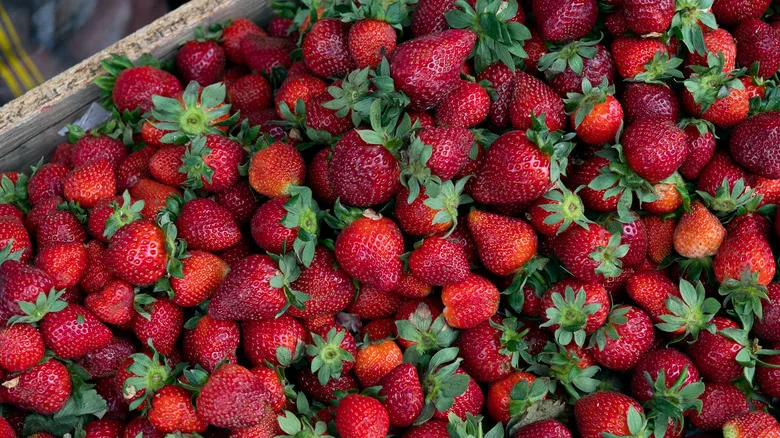Color should be red and vibrant
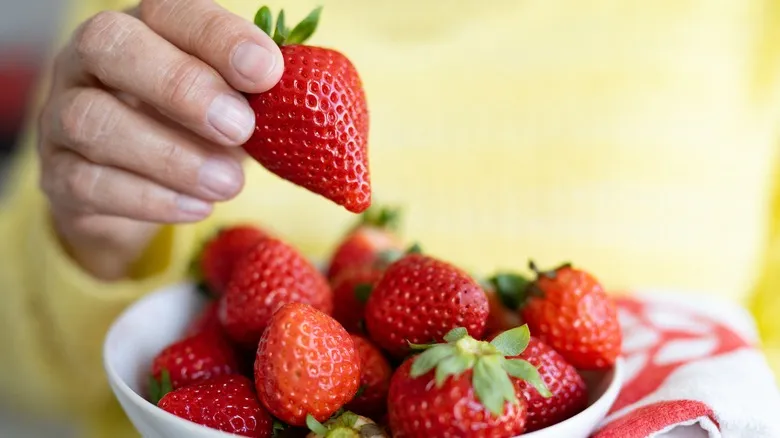
When selecting the finest strawberries, the color is your primary indicator. The perfect strawberry should exhibit a bright, vibrant red hue all over. While a slight green or white tint near the leafy crown is acceptable, the main body should be uniformly red. If you notice mottled white or green patches on the fruit, it indicates that the strawberry is not fully ripe. Pay particular attention to the pointed tip; if it’s red, you’re likely onto a good choice. However, if the tip is a different color, it’s best to pass on that one.
Color can also help you identify strawberries that are no longer fresh. Avoid strawberries with white, fuzzy spots (which indicate mold) or those with black, sunken blemishes on the surface, as these are signs of disease.
You may come across strawberries with minor bruising, which appears as darker red, dented areas. According to USDA standards, if the bruise is larger than half an inch, it’s considered defective, so it’s best to avoid it. If the bruising is smaller, you can still use them in recipes where appearance isn’t crucial, such as for a frozen strawberry daiquiri. However, if you plan to enjoy them fresh or incorporate them into a strawberry pasta dish, opt for fresher, undamaged strawberries instead.
A fresh-looking green cap at the top
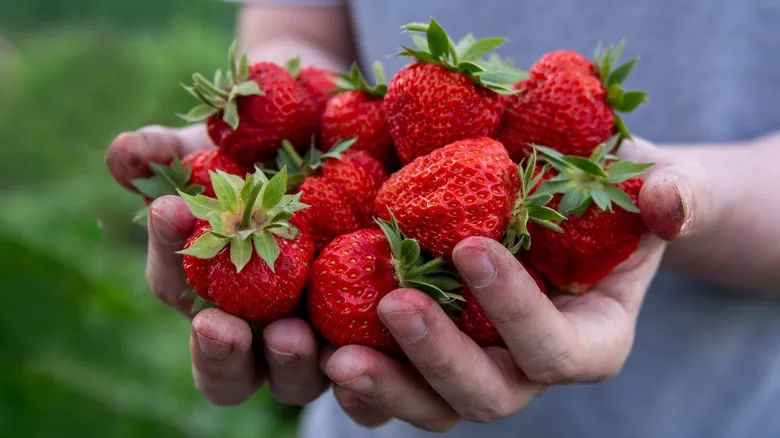
Examine the small cluster of leaves that adorn the strawberry. While many refer to them as the "strawberry cap," their botanical name is the calyx. This part serves a purpose beyond being a simple green crown that you might remove before eating; it can provide valuable insights into the fruit's quality.
When choosing strawberries, seek out those with large, robust leaves that radiate from the center of the berry. A healthy strawberry will have leaves that are a vibrant green and appear fresh. Be cautious if you notice any discoloration, such as yellow or black spots. Yellowing leaves often suggest that the strawberry is beginning to wilt, while dark, mottled spots may indicate disease.
To ensure quality, gently touch the leaves with your fingers. They should feel soft and flexible. If the leaves are dry or brittle, resembling dried tea leaves, it's advisable to select a different strawberry, as this one is likely not worth your time.
A sweet, fruity scent
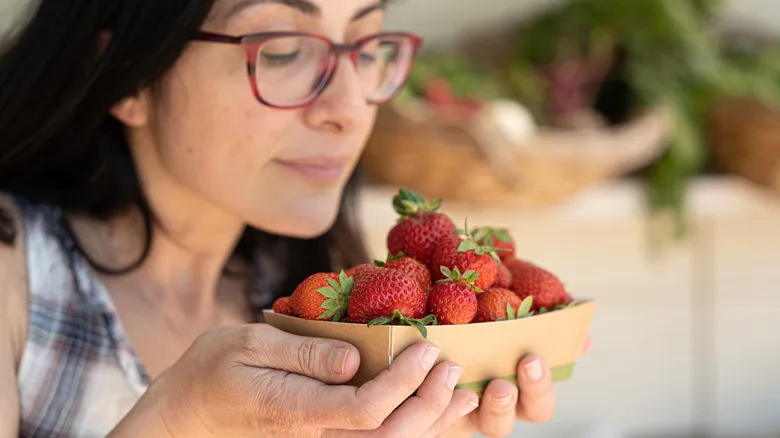
Your sense of smell can be quite useful as well. Ripe strawberries emit a unique fragrance that many people describe as "caramel-like." This delightful aroma comes from a compound known as HDMF (or strawberry furanone) that strawberries release when they reach their peak ripeness.
To test this—if you're in a place where it's appropriate—grab a handful of strawberries and take a sniff. If you detect a sweet, "strawberry-like" scent, chances are you're holding some excellent berries. On the other hand, if there's no aroma at all, the strawberries may not be fully ripe. And if you encounter a strong, unpleasant odor, check through the batch to identify the spoiled ones.
Don't be overly concerned if you find one bad strawberry among the ones you're inspecting. Unlike apples, a single moldy or damaged strawberry won't ruin the entire lot. As long as less than a quarter of the batch has that off-putting smell, you can discard the bad ones and keep the rest if they meet the other quality standards.
Texture has to be firm, but not mushy
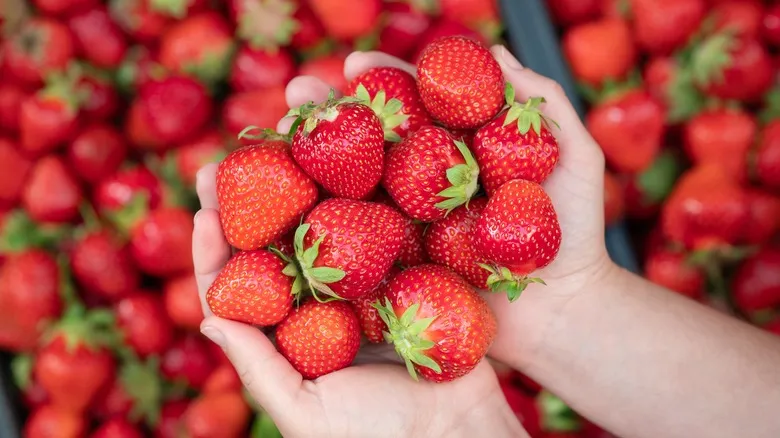
Now that you've examined the appearance and aroma of the strawberries, it's time to assess their texture. You may have noticed experienced pickers gently squeezing the berries, effortlessly determining their quality. You'll be doing the same—provided you're in a place where it's acceptable to handle the berries before purchasing. (If not, remember this tip for your next berry-picking adventure!)
Gently run your hand through the berries and give each one a light squeeze. The perfect strawberry should be plump and firm, with a slight give. When you apply gentle pressure, the flesh should yield a little but quickly bounce back when released. Strawberries that feel mushy and leave a dent when pressed are not ideal for fruit salads or eating fresh. However, if they appear fine otherwise, you can still use them in recipes where texture isn't as crucial, like smoothies and jams. Just be cautious: if a dented strawberry oozes juice when pressed and has bits of pulpy flesh falling out, it's best to discard it—it's past its prime!
The skin of the strawberry should feel smooth and consistent. Watch out for any wrinkles, dry patches, or tight areas, especially if they come with discoloration. If your instincts tell you that a strawberry looks off, trust your gut and select a different one.
Watch out for the season, too!
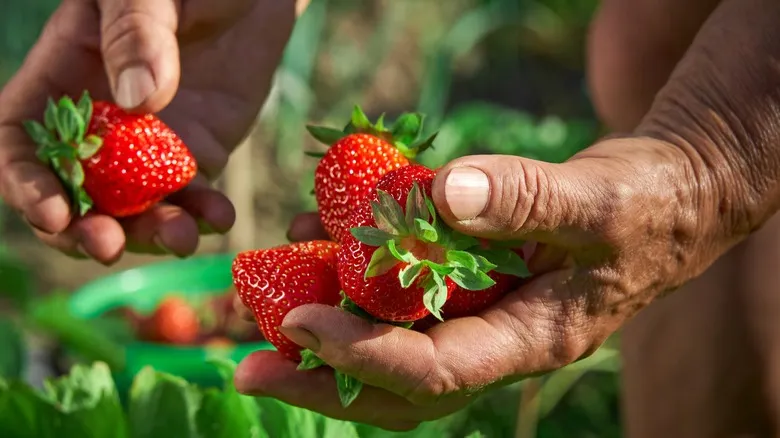
It's important to consider the timing when purchasing strawberries. Thanks to advancements in agriculture, strawberries are now available throughout the year. However, those that are in season tend to be the sweetest and of the highest quality.
The unofficial highlight of strawberry season occurs around May 20, coinciding with National Pick Strawberries Day, when you'll find the finest berries of the year. Nevertheless, the strawberry growing season can actually last from spring to fall. During the later months, be sure to check your local farmers' market or grocery store for restocking, as these vendors often offer strawberries that rival those from earlier in the year.
If you find yourself craving strawberries in the winter, the good news is that frozen or canned strawberries are still an option. While many people may not prefer frozen or canned fruits, the preservation process locks in their peak ripeness while still in the packaging. Therefore, during the off-season, they can be just as delicious as fresh strawberries—if not better—making them perfect for strawberry sauce or as a tasty snack during the colder months.
Recommended

Why Is Costco Members-Only?

What Happened To Costco's Big Competitor Price Club?

Fresh Fruit Is Not The Best Fruit Deal At Costco
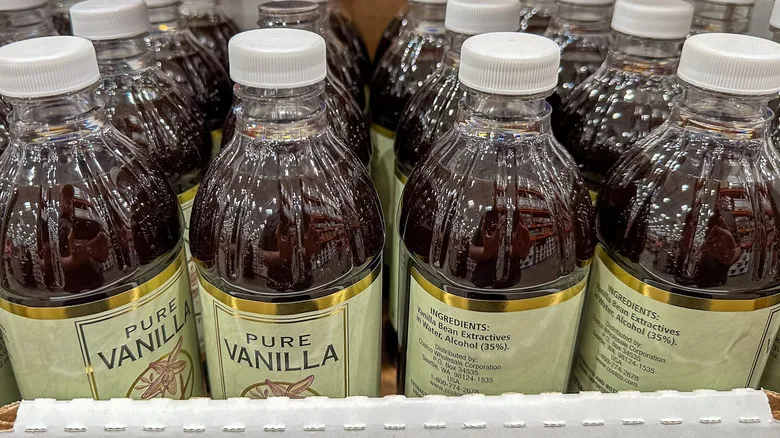
Why It Pays To Buy Your Vanilla Extract At Costco
Next up

